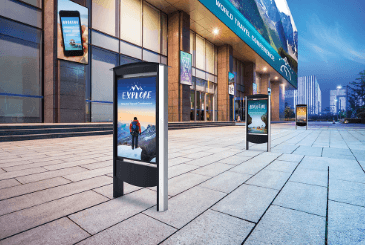Outdoor Digital Signage: A Detailed Guide

Contents
Introduction
Outdoor digital signage is revolutionizing the way businesses communicate with their audiences. These digital displays are increasingly found in various locations, from bustling city centers to tranquil parks, and offer dynamic and engaging content that captures the attention of passersby. This guide delves into the essentials of outdoor digital signage, exploring its benefits, components, installation considerations, and best practices.
Benefits of Outdoor Digital Signage
- Enhanced Visibility: Outdoor digital signage attracts attention with its bright and dynamic displays, making it easier for businesses to convey messages and promotions effectively.
- Flexibility and Real-Time Updates: Unlike static signs, digital signage can be updated instantly, allowing businesses to display timely information such as weather updates, news, or promotional content.
- Engagement: Digital signage can incorporate interactive elements, such as touch screens or QR codes, fostering engagement and enhancing user experience.
- Cost-Effective: Over time, digital signage can be more cost-effective than traditional signage due to reduced printing and installation costs for new campaigns.
Components of Outdoor Digital Signage
- Displays: The core component, available in various sizes and resolutions. High-brightness screens are essential for visibility in direct sunlight.
- Enclosures: These protect the display from weather conditions, vandalism, and extreme temperatures. Enclosures often include ventilation and heating systems.
- Media Players: Devices that store and play the content displayed on the screens. They can be integrated into the display or separate units.
- Content Management Systems (CMS): Software platforms that allow users to create, schedule, and manage the content displayed on their digital signage.
- Connectivity: Essential for updating content remotely. Options include Wi-Fi, Ethernet, and sometimes cellular connections for remote locations.
Installation Considerations
- Location: Choosing the right location is crucial. High-traffic areas are ideal, but it’s also important to ensure the display is not obstructed and is visible from a distance.
- Power Supply: Reliable power sources are necessary to ensure uninterrupted operation. Backup power solutions may also be considered for critical signage.
- Mounting and Orientation: Proper mounting solutions, such as poles, wall mounts, or freestanding structures, must be secure and stable. Orientation should minimize glare and maximize visibility.
- Weatherproofing: Ensuring the signage is protected against rain, snow, dust, and extreme temperatures is essential for longevity and performance.
- Regulatory Compliance: Adherence to local regulations regarding signage placement, brightness, and content is crucial to avoid legal issues.
Content Strategy
- Engaging Content: The content should be visually appealing and relevant to the target audience. High-quality images, videos, and animations can significantly enhance engagement.
- Clear Messaging: Messages should be concise and easy to understand at a glance. Use large fonts and high-contrast colors for readability.
- Dynamic Content: Incorporate real-time information such as news, weather, or social media feeds to keep the content fresh and engaging.
- Interactivity: Encourage interaction through touch screens or by integrating mobile-friendly features like QR codes and SMS marketing.
- Regular Updates: Regularly update the content to reflect current promotions, events, and other timely information.
Maintenance and Monitoring
- Regular Inspections: Periodic inspections to check for damage, wear, or technical issues are essential to maintain optimal performance.
- Software Updates: Keeping the software, including the CMS and media players, updated ensures security and functionality.
- Content Monitoring: Regularly monitoring the displayed content ensures it is functioning correctly and remains relevant.
- Technical Support: Having access to technical support can resolve issues quickly and minimize downtime.
Case Studies
- Retail: Outdoor digital signage in retail settings can drive foot traffic by showcasing promotions and new arrivals, creating an enticing visual experience for shoppers.
- Transportation: Digital signage at transportation hubs provides real-time updates on schedules, delays, and important announcements, improving the travel experience.
- Hospitality: Hotels and restaurants use outdoor digital signage to display menus, special offers, and events, enhancing guest engagement and satisfaction.
Conclusion
Outdoor digital signage is a powerful tool that offers numerous benefits for businesses and organizations. By understanding its components, installation considerations, content strategies, and maintenance needs, businesses can effectively leverage outdoor digital signage to enhance communication, engagement, and overall customer experience. As technology continues to evolve, the potential applications and benefits of outdoor digital signage will only grow, making it an essential element of modern marketing and information dissemination strategies.






